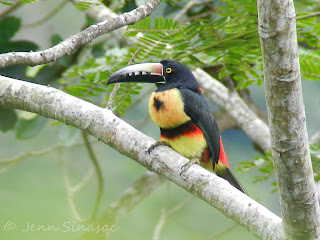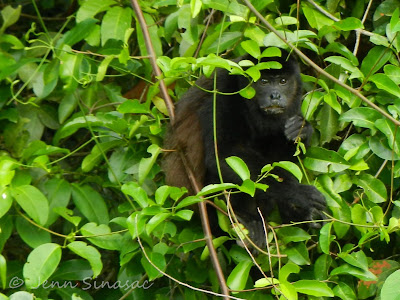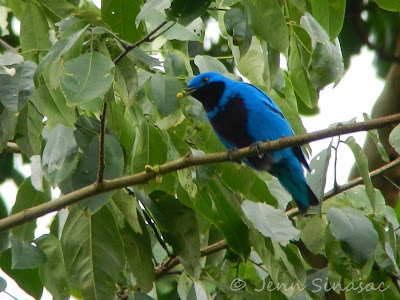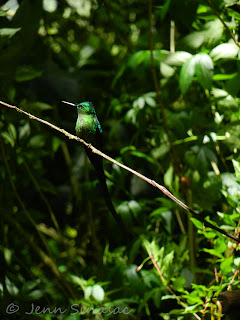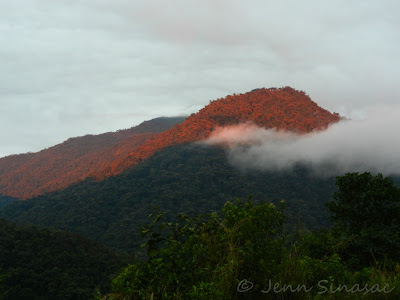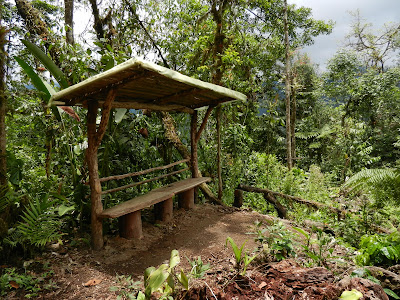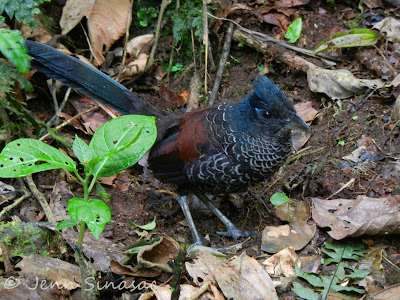 |
| Sumaco Volcano |
I continued my travels in eastern Ecuador into the foothills of the
Andes. On November 5-7, I visited a community called Pacto Sumaco, located approximately from Tena by bus. Pacto Sumaco is a small community of farming
families, and is surrounded by extensive protected areas including the
Sumaco nearby Napo-Galeras National Park and the Gran Sumaco Biosphere
Reserve (400-3900 masl) surrounding the Sumaco Volcano, a designated UNESCO World
Biosphere Reserve. Prior to my visit, I had only passed through this
area numerous times by bus, always wanting to return to do some
exploring and birding. The environment is is very biologically diverse,
and is home to a multitude of plants and animals, including the rare and vulnerable Military Macaw, and includes areas of
primary forest, extensive secondary forest and intermixed with open
areas from the local farming communities surrounding the area.
 |
| Lush humid secondary forest at Pacto Sumaco |
Getting to Pacto Sumaco was an adventure all together. The community itself is located 8 km off the main highway that goes from Tena to Coca, at the end of the road, less than a kilometre past WildSumaco Lodge. I met my friend David Ortega, the director of the Turismo Comunitario in Pacto Sumaco, in Tena and we headed by bus to the community later that afternoon. Usually this is a rather uneventful and easy trip; however, there is currently a bridge along the highway that is under construction for the next several months, and requires a transfer of vehicles as the bridge can only be walked across at the moment. By the time we got to the bridge, it was dark and raining very heavily. We crossed the bridge by foot and not too long later were in the back of a truck headed to Pacto Sumaco. All seemed great until the truck headed out on the highway, and stalled almost immediately. Starting up again, the truck drove a little further and stalled again. There appeared to be a poor connection between a cable that connected the headlights to the engine, so after several stalls on the main highway, we finally made it to the road to Pacto Sumaco. Very dark and very rainy, and in order to get enough engine power to make it up the road the drive needed to turn off the lights, and we guided the driver with headlamps and cellphone lights and by voice "por la derecha!", "por la izquierda!", and eventually made it safely to the community, a little wide-eyed and a little later than expected!
 |
| Sunrise over the Sumaco landscape |
The next morning we started out early. David showed me the cabana they have built near the community that has an incredible view of the surrounding environment and is in the perfect location to watch Chestnut-fronted Macaws flyby at sunrise. The community's tourism initiative at the moment has 1 cabana that can accommodate up to 8 people, and have just received funding to build 4 more cabanas, which should be completed in the near future. The Turismo Comunitario de Pacto Sumaco offers excursions to the crater of Sumaco Volcano, a 3-4 day round trip hike from the community. In addition to visiting the volcano, the area is rich in birdlife and attracts visitors, birders and biologists from all over the world.
 |
| Squirrel Cuckoo, Piaya cayana, drying out after a rainstorm. |
My interest in visiting Pacto Sumaco was to go birding; and David, a budding naturalist with an excellent knowledge of the plants of the area, is interested in learning more about the birdlife in the area as well. The surrounding area is home to approximately 500 species of birds, where impressively 224 of them are regional specialties. The area spans varying altitude ranges, and therefore there is a nice mix of upper eastern slope, cloud forest species and amazonian lowland species. Highlights included Chestnut-fronted Macaw, Wire-crested Thorntail, Gorgeted Woodstar, Black-billed Thrush, Spotted Tanager, Chestnut-crowned Gnateater, Olivaceous Siskin, Dark-breasted Spinetail, Lined Antshrike, Amazonian Umbrellabird, Bronze-green Euphonia, Golden-eared Tanager and Grayish Saltator. It is also an important destination for boreal and austral migrants, and we saw no shortage of Scarlet and Summer Tanagers, Western Wood-Pewees, an Olive-sided Flycatcher, Blackburnian Warblers and lucked out with 2 (possibly 3) Cerulean Warblers.
 |
| Packing naranjillas in Pacto Sumaco |
In addition to being out on the trails and birding, there were opportunities to help out in the community as well. David's family farms naranjillas and were doing a monthly harvest while I was there, so when not out birding, I helped with packing naranjillas and preparing them to be taken to market in Ambato!
Thanks to the friendship and hospitality of David Ortega and the community of Pacto Sumaco for a nice visit! If you are in eastern Ecuador and interested in birding at Pacto Sumaco, you can check out their website for more information.
~ Jenn



